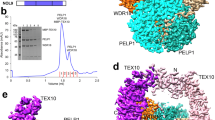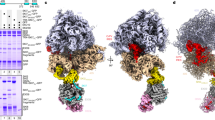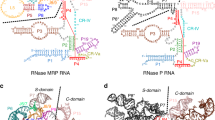Abstract
The exosome is the major 3′–5′ RNA-degradation complex in eukaryotes. The ubiquitous core of the yeast exosome (Exo-10) is formed by nine catalytically inert subunits (Exo-9) and a single active RNase, Rrp44. In the nucleus, the Exo-10 core recruits another nuclease, Rrp6. Here we crystallized an approximately 440-kilodalton complex of Saccharomyces cerevisiae Exo-10 bound to a carboxy-terminal region of Rrp6 and to an RNA duplex with a 3′-overhang of 31 ribonucleotides. The 2.8 Å resolution structure shows how RNA is funnelled into the Exo-9 channel in a single-stranded conformation by an unwinding pore. Rrp44 adopts a closed conformation and captures the RNA 3′-end that exits from the side of Exo-9. Exo-9 subunits bind RNA with sequence-unspecific interactions reminiscent of archaeal exosomes. The substrate binding and channelling mechanisms of 3′–5′ RNA degradation complexes are conserved in all kingdoms of life.
This is a preview of subscription content, access via your institution
Access options
Subscribe to this journal
Receive 51 print issues and online access
$199.00 per year
only $3.90 per issue
Buy this article
- Purchase on SpringerLink
- Instant access to full article PDF
Prices may be subject to local taxes which are calculated during checkout





Similar content being viewed by others
References
Lykke-Andersen, S., Brodersen, D. E. & Jensen, T. H. Origins and activities of the eukaryotic exosome. J. Cell Sci. 122, 1487–1494 (2009)
Houseley, J. & Tollervey, D. The many pathways of RNA degradation. Cell 136, 763–776 (2009)
Mitchell, P., Petfalski, E., Shevchenko, A., Mann, M. & Tollervey, D. The exosome: A conserved eukaryotic RNA processing complex containing multiple 3′->5′ exoribonucleases. Cell 91, 457–466 (1997)
Lorentzen, E. et al. The archeal exosome core is a hexameric ring structure with three catalytic subunits. Nature Struct. Mol. Biol. 12, 575–581 (2005)
Büttner, K., Wenig, K. & Hopfner, K.-P. Structural framework for the mechanism of archaeal exosomes in RNA processing. Mol. Cell 20, 461–471 (2005)
Liu, Q., Greimann, J. C. & Lima, C. D. Reconstitution, activities, and structure of the eukaryotic RNA exosome. Cell 127, 1223–1237 (2006)
Lorentzen, E. & Conti, E. Structural basis of 3′ end RNA recognition and exoribonucleolytic cleavage by an exosome RNase PH core. Mol. Cell 20, 473–481 (2005)
Navarro, M. V. A. S., Oliverira, C. C., Zanchin, N. I. T. & Guimarães, B. G. Insights into the mechanism of progressive RNA degradation by the archaeal exosome. J. Biol. Chem. 283, 14120–14131 (2008)
Hardwick, S. W., Gubbey, T., Hug, I., Jenal, U. & Luisi, B. F. Crystal structure of Caulobacter crescentus polunucleotide phosphorylase reveals a mechanism of RNA substrate channelling and RNA degradosome assembly. Open Biol. 2, 120028 (2012)
Dziembowski, A., Lorentzen, E., Conti, E. & Séraphin, B. A single subunit, Dis3, is essentially responsible for yeast exosome core activity. Nature Struct. Mol. Biol. 14, 15–22 (2007)
Noguchi, E. et al. Dis3, implicated in mitotic control, binds directly to Ran and enhances the GEF activity of RCC1. EMBO J. 15, 5595–5605 (1996)
Allmang, C. et al. The yeast exosome and human PM-Scl are related complexes of 3′->5′ exonucleases. Genes Dev. 13, 2148–2158 (1999)
Lorentzen, E., Basquin, J., Tomecki, R., Dziembowski, A. & Conti, E. Structure of the active subunit of the yeast exosome core, Rrp44: Diverse modes of substrate recruitment in the RNase II nuclease family. Mol. Cell 29, 717–728 (2008)
Bonneau, F., Basquin, J., Ebert, J., Lorentzen, E. & Conti, E. The yeast exosome functions as a macromolecular cage to channel RNA substrates for degradation. Cell 139, 547–559 (2009)
Wasmuth, E. V. & Lima, C. D. Exo- and endoribonucleolytic activities of yeast cytoplasmic and nuclear RNA exosomes are dependent on the noncatalytic core and central channel. Mol. Cell 48, 133–144 (2012)
Lebreton, A., Tomecki, R., Dziembowski, A. & Séraphin, B. Endonucleolytic RNA cleavage by a eukaryotic exosome. Nature 456, 993–996 (2008)
Schaeffer, D. et al. The exosome contains domains with specific endoribonuclease, exoribonuclease and cytoplasmic mRNA decay activities. Nature Struct. Mol. Biol. 16, 56–62 (2009)
Schneider, C., Leung, E., Brown, J. & Tollervey, D. The N-terminal PIN domain of the exosome subunit Rrp44 harbors endonuclease activity and tethers Rrp44 to the yeast core exosome. Nucleic Acids Res. 37, 1127–1140 (2009)
Wang, H.-W. et al. Architecture of the yeast Rrp44 exosome complex suggests routes of RNA recruitment for 3′ end processing. Proc. Natl Acad. Sci. USA 104, 16844–16849 (2007)
Malet, H. et al. RNA channelling by the eukaryotic exosome. EMBO Rep. 11, 936–942 (2010)
Briggs, M. W., Burkard, K. T. & Butler, J. S. Rrp6, the yeast homologue of the human PM-Scl 100-kDa autoantigen, is essential for efficient 5.8S rRNA 3′ end formation. J. Biol. Chem. 273, 13255–13263 (1998)
Cristodero, M., Böttcher, B., Diepholz, M., Scheffzek, K. & Clayton, C. The Leishmania tarentolae exosome: purification and structural analysis by electron microscopy. Mol. Biochem. Parasitol. 159, 24–29 (2008)
Callahan, K. P. & Butler, J. S. Evidence for core exosome independent function of the nuclear exoribonuclease Rrp6p. Nucleic Acids Res. 36, 6645–6655 (2008)
Lorentzen, E., Dziembowski, A., Lindner, D., Seraphin, B. & Conti, E. RNA channelling by the archaeal exosome. EMBO Rep. 8, 470–476 (2007)
Frazão, C. et al. Unravelling the dynamics of RNA degradation by ribonuclease II and its RNA-bound complex. Nature 443, 110–114 (2006)
Schneider, C., Kudla, G., Wlotzka, W., Tuck, A. & Tollervervey, D. Transcriptome-wide analysis of exosome targets. Mol. Cell 48, 422–433 (2012)
Lupas, A., Flanagan, J. M., Tamura, T. & Baumeister, W. Self-compartmentalizing proteases. Trends Biochem. Sci. 22, 399–404 (1997)
Greimann, J. C. & Lima, C. D. Reconstitution of RNA exosomes from human and Saccharomyces cerevisiae cloning, expression, purification, and activity assays. Methods Enzymol. 448, 185–210 (2008)
Schneider, C. A., Rasband, W. S. & Eliceiri, K. W. NIH image to ImageJ: 24 years of image analysis. Nature Methods 9, 671–675 (2012)
Kabsch, W. XDS. Acta Crystallogr. D 66, 125–132 (2010)
Oddone, A. et al. Structural and biochemical characterization of the yeast exosome component Rrp40. EMBO Rep. 8, 63–69 (2007)
McCoy, A. J. et al. Phaser crystallographic software. J. Appl. Crystallogr. 40, 658–674 (2007)
Winn, M. D. et al. Overview of the CCP4 suite and current developments. Acta Crystallogr. D. 67, 235–242 (2011)
Emsley, P. & Cowtan, K. Coot: model-building tools for molecular graphics. Acta Crystallogr. D 60, 2126–2132 (2004)
Adams, P. D. et al. PHENIX: a comprehensive Python-based system for macromolecular structure solution. Acta Crystallogr. D 66,. 213–221 (2010)
The PyMOL Molecular Graphics System. v. 1.2r3pre (Schrödinger, LLC).
Baker, N. A., Sept, D., Joseph, S., Holst, M. J. & McCammon, J. A. Electrostatics of nanosystems: application to microtubules and the ribosome. Proc. Natl Acad. Sci. USA 98, 10037–10041 (2001)
Ashkenazy, H., Erez, E., Martz, E., Pupko, T. & Ben-Tal, N. ConSurf 2010: calculating evolutionary conservation in sequence and structure of proteins and nucleic acids. Nucleic Acids Res. 38, W529–W533 (2010)
Reichmann, D. et al. Binding hot spots in the TEM1-BLIP interface in light of its modular architecture. J. Mol. Biol. 365, 663–679 (2007)
Acknowledgements
We would like to thank the Max Planck Institute Biochemistry Core Facility and Crystallization Facility; the staff members at beamlines X10SA (Swiss Light Source) and ID23-2 (European Synchrotron Radiation Facility) for support; F. Bonneau for the assay in Supplementary Fig. 6; J. Ebert, J. Basquin and F. Bonneau for initial materials and reagents; and P. Birle and T. Krywcun for technical assistance. We also thank members of our laboratory for discussions and critical reading of the manuscript. This study was supported by the Max Planck Gesellschaft, the ERC Advanced Investigator Grant 294371 and the Deutsche Forschungsgemeinschaft (SFB646, SFB1035, GRK1721 and CIPSM) to E.C.
Author information
Authors and Affiliations
Contributions
D.L.M. and E.C. designed the experiments. M.B. purified several exosome components. D.L.M. performed all other experiments and solved the structure. D.L.M. and E.C. wrote the manuscript.
Corresponding author
Ethics declarations
Competing interests
The authors declare no competing financial interests.
Supplementary information
Supplementary Information
This file contains Supplementary Tables 1-2, Supplementary Figures 1-6 and additional references. (PDF 5037 kb)
Rights and permissions
About this article
Cite this article
Makino, D., Baumgärtner, M. & Conti, E. Crystal structure of an RNA-bound 11-subunit eukaryotic exosome complex. Nature 495, 70–75 (2013). https://doi.org/10.1038/nature11870
Received:
Accepted:
Published:
Issue Date:
DOI: https://doi.org/10.1038/nature11870
This article is cited by
-
RNA compaction and iterative scanning for small RNA targets by the Hfq chaperone
Nature Communications (2024)
-
Exosomes derived from human adipose-derived stem cells ameliorate osteoporosis through miR-335-3p/Aplnr axis
Nano Research (2022)
-
Global view on the metabolism of RNA poly(A) tails in yeast Saccharomyces cerevisiae
Nature Communications (2021)
-
The zinc-finger protein Red1 orchestrates MTREC submodules and binds the Mtl1 helicase arch domain
Nature Communications (2021)



